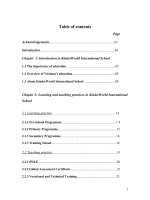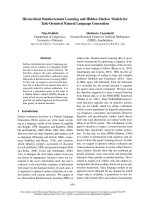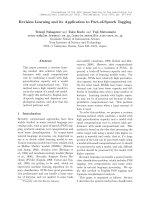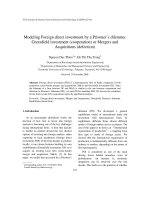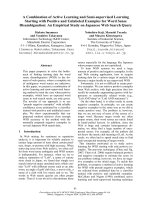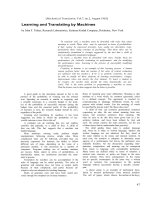Learning and acquisition
Bạn đang xem bản rút gọn của tài liệu. Xem và tải ngay bản đầy đủ của tài liệu tại đây (185.34 KB, 22 trang )
<span class='text_page_counter'>(1)</span><div class='page_container' data-page=1>
<i><b>LOGO</b></i>
<b>LEARNING & </b>
<b>ACQUISITION</b>
</div>
<span class='text_page_counter'>(2)</span><div class='page_container' data-page=2>
<b>Some concepts</b>
1st language: the mother tongue / native
language / L1
2nd language: the widely used in the
environment
</div>
<span class='text_page_counter'>(3)</span><div class='page_container' data-page=3></div>
<span class='text_page_counter'>(4)</span><div class='page_container' data-page=4>
<b>Three ways</b>
picking up the language <sub></sub> exposure to lots
of examples <sub></sub> acquisition takes place over
a period of time <sub></sub> a silent period.
Using L2 in interaction with other people.
Focusing on the form of L2
</div>
<span class='text_page_counter'>(5)</span><div class='page_container' data-page=5>
<b>Acquisition</b>
How children acquire L1?
<sub>Exposure to L1 </sub>
</div>
<span class='text_page_counter'>(6)</span><div class='page_container' data-page=6>
<b>2</b>
<b>nd</b><b> language acquisition</b>
A subconscious process <sub></sub> expose to
samples of the 2nd language that we
understand.
Acquirers <sub></sub> not consciously aware of the
grammatical rules
Not concentrate on form, but in the
</div>
<span class='text_page_counter'>(7)</span><div class='page_container' data-page=7>
<b>Acquisition </b>
More important for natural, fluent
communication.
Lrs. are quite fluent without ever having
learned rules
Lrs. should be exposed to
</div>
<span class='text_page_counter'>(8)</span><div class='page_container' data-page=8>
<b>Learning</b>
A conscious process of study and
attention to form and rule learning.
</div>
<span class='text_page_counter'>(9)</span><div class='page_container' data-page=9>
<b>Acquisition</b> <b>Learning</b>
• Subconscious
•<sub> Natural</sub>
• Long lasting
• Successful
•<sub> Attention to meaning</sub>
• Fluent
• Conscious
•<sub> Unnatural</sub>
• Short lasting
• Unsuccessful
•<sub> Attention to form and </sub>
rule learning
</div>
<span class='text_page_counter'>(10)</span><div class='page_container' data-page=10>
<b>The input hypothesis</b>
Input: what students hear or read
Comprehensible / roughly-tuned input:
forms and structures which are just
beyond the learner’s current level of
competence in the language.
</div>
<span class='text_page_counter'>(11)</span><div class='page_container' data-page=11>
<b>The input hypothesis</b>
only concerned with acquisition, not
learning
</div>
<span class='text_page_counter'>(12)</span><div class='page_container' data-page=12>
<b>Baseline talk</b>
</div>
<span class='text_page_counter'>(13)</span><div class='page_container' data-page=13>
<b>Modified input / Adjusted speech</b>
1st language: child-directed speech/
caretaker talk / mother talk /
motherese / baby talk
</div>
<span class='text_page_counter'>(14)</span><div class='page_container' data-page=14>
<b>child-directed speech</b>
The way parents talk to little children
Features:
Slower rate of speech
Higher pitch
More varied intonation
Shorter, simpler sentence patterns
Frequent repetition
Paraphrase
</div>
<span class='text_page_counter'>(15)</span><div class='page_container' data-page=15>
<b>Foreigner talk</b>
NS modify their speech when
communicating with NNS
</div>
<span class='text_page_counter'>(16)</span><div class='page_container' data-page=16>
Base line talk: you won’t forget to buy
the ice cream on your way home, will
you?
UG FT: No forget buying ice cream, eh?
GFT: The ice cream – you will not forget
</div>
<span class='text_page_counter'>(17)</span><div class='page_container' data-page=17>
<b>Ungrammatical FT</b> <b>Grammatical FT</b>
• Socially market
• NS’s lack of respect
• Features:
o Deletion of “be” / modal
verbs / articles
o Using base form for past
tense
o Using special
construction like “no + V”
• The norm
• Features:
o Delivered at a slower
pace
o The input is simplified
(shorter sent., no
subordinate clauses)
o Regularised
</div>
<span class='text_page_counter'>(18)</span><div class='page_container' data-page=18>
<b>Implication</b>
Make learning like acquisition by:
Giving learners both finely-tuned and
roughly-tuned input (use authentic
materials)
Modifying the input like the way parents
talk to little children
</div>
<span class='text_page_counter'>(19)</span><div class='page_container' data-page=19>
<b>Teaching</b>
Young Lrs. : avoid grammar teaching,
children subconsciously acquire lg.
Adult Lrs.: focused lg. study = useful,
desirable + activities that match
</div>
<span class='text_page_counter'>(20)</span><div class='page_container' data-page=20>
<b>Principles </b>
Acquisition is more important than
learning
Only acquired language is readily
available for natural, fluent
</div>
<span class='text_page_counter'>(21)</span><div class='page_container' data-page=21>
<b>Modify the following baseline </b>
<b>talk</b>
Advances in medicine and public
sanitation mean that infectious diseases
no longer kill millions of children and
adults as they did in the past.
Our faces make our emotion and
attitudes known, but we should not try to
“read” people from another culture as we
could “read” someone from our own
</div>
<span class='text_page_counter'>(22)</span><div class='page_container' data-page=22>
With the globalisation of information
technology and worldwide access to the
internet, people from all areas of learning
are finding themselves using form of
information technology in the work place.
Pronunciation practice is an important
matter when studying a new language,
as incorrect pronunciation can cause
</div>
<!--links-->
